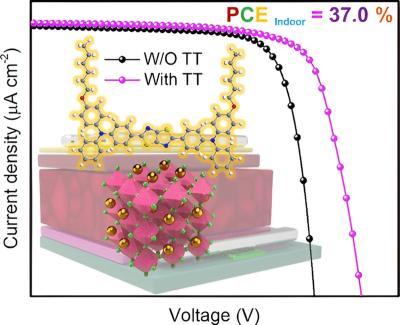Researchers at Kaunas University of Technology (KTU), Ming Chi University of Technology, Belarusian State University and King Abdullah University of Science and Technology (KAUST) have synthesized novel materials to enhance the performance of wide-bandgap perovskite solar cells (PSCs).
Graphical abstract. Credit: ACS Applied Materials & Interfaces (2024)
These can improve solar elements for indoor use, which can also be integrated into various electronic devices, and are able to generate electricity even in low-light conditions.
"Wind and hydro energy are constrained by high costs and location dependency, while solar energy is flexible, efficient and relatively inexpensive. However, the energy from indoor light sources and natural light entering through windows is lost every day," says Juozas Vidas Gražulevičius, Professor at the KTU Faculty of Chemical Technology and Head of the Chemistry of Materials research group.
"Perovskite photovoltaic cells for indoor use can be integrated into mobile phones, pocket flashlights and other electronic devices; they can generate electricity under artificial light. Using Internet of Things (IoT) technologies, this electricity can be used to efficiently regulate the operation of devices and optimize energy consumption," says Dr. Asta Dabulienė, Senior Researcher at the Chemistry of Materials research group, KTU.
With the rapid development of IoT technologies, the market for photovoltaic cells for indoor use has expanded significantly. High-performance, low-cost and versatile indoor PV cells are therefore the key to filling this market gap.
The team synthesized a series of new efficient hole-transporting thiazol[5,4-d]thiazole derivatives for indoor perovskite photovoltaic cells. The main function of their layers is to selectively transport holes (positive charge carriers) while blocking electrons (negative charge carriers). This selective charge transport helps in reducing recombination losses, thereby improving the overall efficiency of the solar cell.
"An ideal hole transporting semiconductor for these applications would possess high hole mobility and good energy level alignment with those of adjacent layers," explains dr. Dabulienė.
A thiazol[5,4-d]thiazole derivative containing a triphenylamine donor fragment, synthesized by KTU researcher Dr. Dabulienė, has been used by a research team at Ming Chi University of Technology (Taiwan) to develop perovskite solar cells for indoor use. The KTU-developed organic semiconductor allowed it to reach a power conversion efficiency of 37.0% under 3000 K LED (1,000 lx) illumination.




